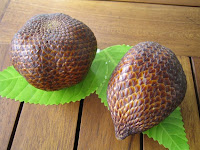THE SNAKE FRUIT TREE, SALAK, SALACCA ZALACCA
The Snake Fruit tree is native to the Indonesian island of Java and Sumatra where it grows wild. It is given this name because its fruit has skin which looks scaly like a snake’s skin. It is a palm tree in the Arecaceae family and is related to the date palm. However it has a shallow root system and although it loves humidity and rain, it is not tolerant of floods. Salak means tree bark, and the dark brown scaly skin of the snake fruit or salak is similar to the colour of bark.
 Snake Fruit is cultivated in Thailand, Malaysia and has been introduced to Queensland, Australia, New Guinea, the Philippines, and Ponope Island in the Caroline Archipelago. It is reported as growing in the pacific Island of Fiji. Now it is grown throughout Indonesia and two of the most famous cultivars are those of Bali (Salak Bali) and Salak Pondah from Java. Salak Pondah is dry and crumbly in texture, while that of Salak Bali is moist and crunchy. They are said to taste like a combination of apple, pineapple and banana. Most of the fruit is consumed in the countries where it grows, as it needs to be eaten within a week of picking to be at its best. A very small fraction of the fruit is exported to Singapore, from whence it may go further afield. It can be found in pickles “asinan salak” as these are called in Indonesia, and candied, known as “manisan salak.” The fruit is also canned and juice is also sold.
Snake Fruit is cultivated in Thailand, Malaysia and has been introduced to Queensland, Australia, New Guinea, the Philippines, and Ponope Island in the Caroline Archipelago. It is reported as growing in the pacific Island of Fiji. Now it is grown throughout Indonesia and two of the most famous cultivars are those of Bali (Salak Bali) and Salak Pondah from Java. Salak Pondah is dry and crumbly in texture, while that of Salak Bali is moist and crunchy. They are said to taste like a combination of apple, pineapple and banana. Most of the fruit is consumed in the countries where it grows, as it needs to be eaten within a week of picking to be at its best. A very small fraction of the fruit is exported to Singapore, from whence it may go further afield. It can be found in pickles “asinan salak” as these are called in Indonesia, and candied, known as “manisan salak.” The fruit is also canned and juice is also sold.  Even where it is cultivated this fruit is not common, and in November 2010 the production of the Salak Pondah was hit when Mount Merapi erupted and volcanic ash destroyed the fruit trees in Yogyakarta province where there are around thirty cultivars of Snake Fruit trees. There is an area of 20 kilometres in diameter around Mount Merapi where crops have bee decimated by the ash from the volcano, and as these trees take three or four years to bear fruit, the farmers are in the region have been hard hit.
Even where it is cultivated this fruit is not common, and in November 2010 the production of the Salak Pondah was hit when Mount Merapi erupted and volcanic ash destroyed the fruit trees in Yogyakarta province where there are around thirty cultivars of Snake Fruit trees. There is an area of 20 kilometres in diameter around Mount Merapi where crops have bee decimated by the ash from the volcano, and as these trees take three or four years to bear fruit, the farmers are in the region have been hard hit. The Snake Fruit trees need to be grown under shade trees and are often interspersed with banana and mango trees. The fruit grows in clusters at the base of the tree and they weigh on average about 90 grams each. The fruit is pointed at each end, and has seeds in it. The seeds of the unripe Salak Pondah fruit are edible, but those of other cultivars are not. The fruit is rich in vitamin C in the form of ascorbic acid, and contains flavonoids and phenolic compounds. Little research has been done on this tree and its fruit, although what has been done suggests that it has potent antioxidant properties. This is perhaps that the palm is a relatively recent discovery to the world, as it was only found in the 1980s. Unlike tropical fruits like the mangosteen, rambutan and lychee, the snake fruit is not soft and succulent, but on the contrary is generally firm and crisp. Unripe snake fruit is pickled and also used in a salad called rujak.
The Snake Fruit trees need to be grown under shade trees and are often interspersed with banana and mango trees. The fruit grows in clusters at the base of the tree and they weigh on average about 90 grams each. The fruit is pointed at each end, and has seeds in it. The seeds of the unripe Salak Pondah fruit are edible, but those of other cultivars are not. The fruit is rich in vitamin C in the form of ascorbic acid, and contains flavonoids and phenolic compounds. Little research has been done on this tree and its fruit, although what has been done suggests that it has potent antioxidant properties. This is perhaps that the palm is a relatively recent discovery to the world, as it was only found in the 1980s. Unlike tropical fruits like the mangosteen, rambutan and lychee, the snake fruit is not soft and succulent, but on the contrary is generally firm and crisp. Unripe snake fruit is pickled and also used in a salad called rujak.


